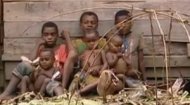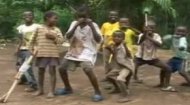|
There are four major ethnic groups inside the Republic of Congo - these groups are the Kongo, the M'Bochi, the Sangha and the Teke. Additionally, the Baka people, often called pygmies, live in the country and rainforest regions (See separate article, below).
Religion plays a dominant and visible role in everyday Congolese existence. The majority of the population identifies as Christian, primarily Catholic or Protestant, with various syncretic and revivalist churches also holding substantial sway. Churches are not only places of worship but also vital community centres, providing social cohesion and moral guidance. Sunday is dedicated almost entirely to religious activities, characterised by long, vibrant, and musical services. Analysing the physical infrastructure reveals a significant gap between the country's potential and its existing realities. Housing in the major cities presents a sharp duality for the 60% of the population who live in Brazzaville and Pointe Noire, with a further 12% living close to the railway that connects those two cities. In the central business districts and wealthier neighbourhoods, modern apartment complexes and villas stand alongside older colonial-era buildings. However, the vast majority of urban dwellers live in sprawling quarters characterised by concrete single-story or multi-story structures, often built incrementally as family resources permit. These areas frequently lack formalised urban planning, leading to difficulties in accessing basic services. The remaining 28%, including the indigenous Pygmy population, live in rural communities, normally in homes made of mud bricks with thatched or tin roofs with no access to electricity, relying upon wood for fuel. |
Life in Congo Brazzaville |
Life in Congo Brazzaville |
Life in Congo Brazzaville | Life in Congo Brazzaville |
|

|
The provision of reliable water and sanitation is one of the most pressing national challenges in Congo Brazzaville. While access to clean drinking water is relatively high by regional standards, with 84% of the urban population now having access, service is often intermittent, particularly outside the capital, where only 27% have access to safe water. Many urban residents rely on communal standpipes (see image, above) or private boreholes, leading to concerns about water quality. More critically, the state of sanitation infrastructure is rudimentary in many urban and rural areas where water continues to be collected from springs and wells and is also of questionable quality with dozens of children regularly being admitted to hospital because of chronic diarrhoea, with dysentery being one of the main cause of death in the country not least because access to healthcare varies considerably with 66% of all doctors in the country living and working in the capital city of Brazzaville. Adequate sewerage systems are uncommon, and waste management, including the collection and disposal of solid and liquid waste, remains a major public health issue. This deficit directly contributes to the spread of waterborne diseases, particularly during the rainy season. Congo Brazzaville has a current infant mortality (under fives) rate of 27.6 for every 1000 births compared with 44.5 deaths per 1000 live births in neighbouring Democratic Republic of Congo. For comparative purposes, the rate is 3.3 deaths per 1000 live births in Europe. Unlike many other African countries, the Republic of Congo does not suffer from lack of rainfall and despite the country having one third of its mass as part of the Congo basin, it still has eight million hectares available for farming to support its population so should be food self sufficient, yet out of that great landmass only 200,000 hectares are used for agriculture. Part of the reason for this is that under Marxist rule, which was abandoned in the early 1990s, peasant organisations were set up to run state farms; however, with the collapse of the state farm policy in 1986, these large farms were abandoned and the agriculture sector became dominated by smallholdings managed by families without the skills and knowledge to work the land effectively. Today most farming in the Republic of Congo is undertaken by around 30% of the workforce and is subsistence farming concentrated on cassava, a hardy plant that thrives in poor soil conditions and is the equivalent of the potato in terms of its use in meals with its starchy roots and protein and vitamin high leaves. In the south of the country, bananas and plantains grow, a banana lookalike vegetable that is used in recipes like potatoes. Other agricultural production includes peanuts, maize and potatoes as well as fruit, whilst cash crops are primarily sugarcane and tobacco. Most rural families also keep chickens, goats, sheep and pigs to supplement their diet. The economic engine of the Republic of Congo is inextricably tied to the volatile global price of oil, which accounts for the vast majority of government revenue and exports. This high dependency is the source of the country’s most profound challenges. When oil prices drop, the government faces immediate fiscal strain, leading to delays in salary payments, reduced investment in public services, and heightened social tension. Diversification efforts have been slow, hampered by bureaucratic inertia and a challenging business environment. Coupled with economic volatility, deep infrastructural deficits impede growth in Congo Brazzaville. Outside the main urban corridors, road networks are poorly maintained, making travel and the transport of goods prohibitively expensive and slow. The inconsistent supply of electricity is another critical hurdle, disrupting everything from small businesses to large industrial operations. These infrastructural limitations contribute to the high cost of living, which is particularly felt by low-income families whose incomes are trapped within the low productivity of the informal sector. Moreover, issues related to governance and transparency are acknowledged main issues that influence investor confidence and the equitable distribution of national resources. The ongoing struggle for improved accountability and reduced corruption is closely linked to the country’s ability to sustainably fund essential services like healthcare, education, and water and sanitation infrastructure improvements. |
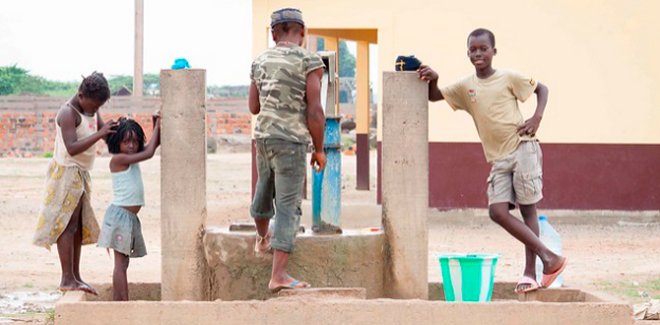
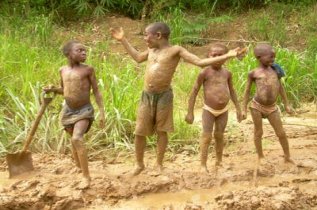
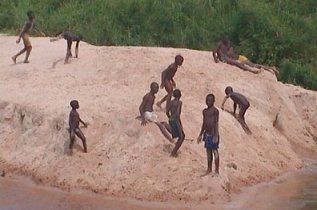 The practical daily life in Congo Brazzaville often begins early. In the cities, the informal economy thrives, underpinning the livelihoods of most residents. Markets, known for their sheer volume and energy, are central to community interaction, employment, and the distribution of goods, from local produce to imported electronics. Transportation is heavily reliant on shared taxis and motorcycle taxis (known locally as zemidjans), which navigate the congested urban landscape. For those employed in the formal sector (government, oil, or international NGOs), the routine is more structured, but the end of the workday invariably leads back to the communal setting of the family home, often centred around cooking, conversation, and shared meals of manioc, fish, or saka-saka (pounded cassava leaves).
The practical daily life in Congo Brazzaville often begins early. In the cities, the informal economy thrives, underpinning the livelihoods of most residents. Markets, known for their sheer volume and energy, are central to community interaction, employment, and the distribution of goods, from local produce to imported electronics. Transportation is heavily reliant on shared taxis and motorcycle taxis (known locally as zemidjans), which navigate the congested urban landscape. For those employed in the formal sector (government, oil, or international NGOs), the routine is more structured, but the end of the workday invariably leads back to the communal setting of the family home, often centred around cooking, conversation, and shared meals of manioc, fish, or saka-saka (pounded cassava leaves).